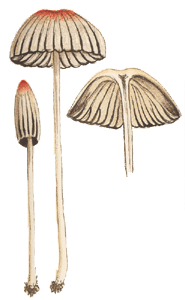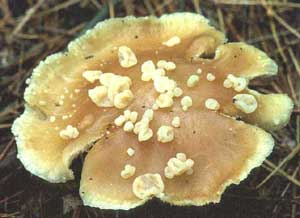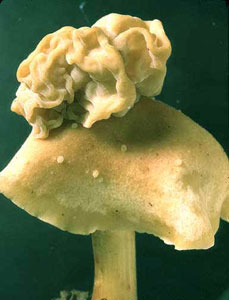 Fungal
ecology
Fungal
ecology
Fungi versus fungi
Many fungi parasitize other fungi. While the bulk of the world’s Cordyceps species parasitize invertebrates, a small number of northern hemisphere species parasitize the fruiting bodies of truffle-like fungi in the genus Elaphomyces. [http://www.nybg.org/bsci/res/hall/elapho.html]
Two examples are Cordyceps ophioglossoides [http://www.nybg.org/bsci/res/hall/ophio.html]
and Cordyceps longisegmentis. [http://www.nybg.org/bsci/res/hall/canaden.html] So far all Australian species of Cordyceps have been found to be parasitize only invertebrates.
The gelatinous, lobed to brain-like fruiting bodies of Tremella are
often found on dead wood. Two commonly seen examples are Tremella fuciformis
![]() and Tremella mesenterica
and Tremella mesenterica ![]() .
For many years it was thought that all of these fungi were simply feeding on
the dead wood, but it is now known that many Tremella species are virulent
parasites on other fungi. This photo
.
For many years it was thought that all of these fungi were simply feeding on
the dead wood, but it is now known that many Tremella species are virulent
parasites on other fungi. This photo ![]() shows a fruiting body of Tremella encephala, ostensibly on some dead
wood. However, cut one of the fruiting bodies in half
shows a fruiting body of Tremella encephala, ostensibly on some dead
wood. However, cut one of the fruiting bodies in half ![]() and you’ll find what looks like a firm, white core inside a gelatinous
outer. The white core is actually the parasitized and deformed fruiting body
of another fungus and the gelatinous outer is the Tremella fruiting body.
and you’ll find what looks like a firm, white core inside a gelatinous
outer. The white core is actually the parasitized and deformed fruiting body
of another fungus and the gelatinous outer is the Tremella fruiting body.
Here is another jelly fungus, Syzygospora mycetophila, growing parasitically on the cap of the mushroom Gymnopus dryophilus. One picture shows a group of small jelly fungus fruiting bodies, the other a single large jelly fungus. These are northern hemisphere species and the photographs were taken by George Barron (who has kindly allowed their reproduction here).
Not all parasitism is on fruiting bodies. In many cases the parasitism occurs well out of sight, with one mycelium attacking another. The attack may be physical (with the hyphae of one mycelium penetrating the hyphae of the other mycelium) or chemical (with the hyphae of one mycelium producing chemicals to dissolve the hyphae of the other mycelium) - or a combination of the two.
The polypore Trametes versicolor ![]() is
found worldwide on decayed wood. This species is not always an initial colonizer
of dead wood, but can appear a little later, and studies in the northern hemisphere
show that this species can replace a number of the early colonizers of dead
wood. However, decayed wood occupied by Trametes versicolor is sometimes
invaded by Lenzites betulina [http://www.mykoweb.com/CAF/species/Lenzites_betulina.html]
which is specifically parasitic on Trametes mycelium. In top view the
species are superficially similar, in that both are leathery-textured bracket
fungi with concentrically zoned caps. However, while Trametes is a polypore,
with numerous tiny pores on the underside of the cap, Lentinus has radiating
gills.
is
found worldwide on decayed wood. This species is not always an initial colonizer
of dead wood, but can appear a little later, and studies in the northern hemisphere
show that this species can replace a number of the early colonizers of dead
wood. However, decayed wood occupied by Trametes versicolor is sometimes
invaded by Lenzites betulina [http://www.mykoweb.com/CAF/species/Lenzites_betulina.html]
which is specifically parasitic on Trametes mycelium. In top view the
species are superficially similar, in that both are leathery-textured bracket
fungi with concentrically zoned caps. However, while Trametes is a polypore,
with numerous tiny pores on the underside of the cap, Lentinus has radiating
gills.
In Europe the fruiting bodies of Poronia punctata, a fairly slow-growing
ascomycete, can be found on old herbivore dung and it has been found that chemicals
produced by that species inhibit the mycelial growth of several other dung fungi.
Poronia punctata does not occur in Australia, but we do have the very
similar Poronia erici ![]() ,
with both species producing fruiting bodies that look like white disks with
black spots. Poronia erici also occurs on old dung, but there have been
no studies into chemical production by this species. Apart from Poronia punctata
there are various other dung fungi in which similarly inhibitory chemicals have
been found. Many species of Coprinus are dung specialists and extremely
antagonistic to other fungi. In laboratory experiments a Coprinus hypha
that comes into contact with the hypha of another fungus causes the almost immediate
collapse of the other hypha.
,
with both species producing fruiting bodies that look like white disks with
black spots. Poronia erici also occurs on old dung, but there have been
no studies into chemical production by this species. Apart from Poronia punctata
there are various other dung fungi in which similarly inhibitory chemicals have
been found. Many species of Coprinus are dung specialists and extremely
antagonistic to other fungi. In laboratory experiments a Coprinus hypha
that comes into contact with the hypha of another fungus causes the almost immediate
collapse of the other hypha.
It is worth noting that when mycelia of different species meet it sometimes happens that neither can overcome the other and there is a deadlock. It depends on the species involved. Antagonism can also occur between two mycelia of the same species.
A tale of two fungi and a springtail
In some cases the interactions between mycelia are influenced by other organisms. An interesting example of this is given by the species Marasmius androsaceus [http://www.bk.tudelft.nl/users/kap/internet/nem/marasmius_androsaceus.html] and Mycena galopus [http://www.pilzepilze.de/piga/zeige.htm?name=mycena_galopus]. In these two species the mycelia produce small mushrooms as fruiting bodies, the caps being several millimetres to a centimetre or so in diameter. They are common in northern hemisphere forests and the mycelia are decomposers of leaf and twig litter. The species are often found growing together, but as both species compete for the same food source it seems surprising to find such co-existence. The dynamics of the two species have been studied in detail in one English forest.
The first thing to be done was to see how effectively each species colonised samples of sterile forest litter. Laboratory tests showed that Marasmius is the superior coloniser of such litter, easily out-competing Mycena. However, Mycena galopus appears to have good defences against a competitor such as Marasmius. When mycelia from the two species are brought together in the laboratory, there is deadlock with Marasmius unable to destroy the Mycena. On the basis of these findings you could still expect the Mycena to have almost insurmountable difficulties in maintaining a significant presence in the forests. After all, it would seem that Marasmius would quickly colonize fresh litter and confine Mycena to limited areas where it would eventually run out of food.
A little more investigation showed that in the forest, the mycelia of the two
species occupy slightly different niches. Marasmius in the upper layers
of the leaf and twig litter, Mycena a little lower. At first sight there
appears to be nothing to stop Marasmius mycelium expanding to the lower
layers but a tiny invertebrate tips the balance. Onychiurus latus, a
species of Collembola (the group commonly called Springtails) lives in leaf
litter and feeds on fungal mycelia. This non-jumping springtail can eat both
Marasmius and Mycena mycelia, but showed a strong preference for
Marasmius. When the laboratory tests (mentioned above) were repeated,
but with the springtails included in the samples of forest litter, Mycena
became the superior coloniser. Paradoxically, it now looks as though Marasmius
would have difficulty surviving. However, one aspect of springtail behaviour
allows the co-existence of the two fungi. The springtail is prone to desiccation
and, during the drier months, would move into the lower layers of the forest
litter. So, during those times Marasmius mycelia could feed in the upper
litter and there build up the biomass necessary for mushroom formation, unhindered
by springtails. The
concentration of springtails in the lower litter would keep Marasmius
mycelium in check at that depth and allow Mycena free rein in that area![]() .
.
![An Australian Government Initiative [logo]](/images/austgovt_brown_90px.gif)



